Abstract
The urgency of the problem is explained by the fact that teen-age is characterized as adolescent period of changes in relations with parents and peers. There is a readiness for vital personal identity, establishment of the harmonious relationship with people around and with self. The purpose of this article is to investigate the concatenation of perceptions between parents’ relations and teenage communicative culture. The leading methods of investigating this problem is the theoretical analysis of psychological literature, as well as the method of empirical research (testing), with the use of techniques to diagnose the perception about parenting through the eyes of teenagers and their communicative culture. The experiment involved 60 adolescents: 30 boys and 30 girls of 14-15 years old, 9 grade students. The article reveals that the hypoprotection style prevails in the boys education, the girls have a predominant style of hyperprotection. The study of the teenage communicative culture revealed that self-assessment indicators of organizational and communicative qualities for boys and girls are characterized by their adaptive behavior. The teenage boys have an increased level of communicative competence and communication skills. Girls are highly dependent on the others opinions. The analysis of the correlation shows that there is a correlation between the views on the parents attitude and the teenage communicative culture and there are differences in the features of the views on the parents attitude and boys and girls communicative culture because of inter-sex characteristics.
Keywords: Teenagersfamily relationshipschild-parent relationsfamily-style educationcommunicative culture
Introduction
The urgency of the problem becomes apparent when you review the large number of investigations devoted to studying of family style education and the teenage communication culture. However, there are not enough scientific works devoted to the consideration of the problem in several aspects. This study aims to fill this gap. In the context of this problem, it is exactly in the family atmosphere we acquire the basic attitudes to view of the world, to ourselves, to relationships with other people. An important aspect of the study is the role of both parents in upbringing, in particular, those styles of parental attitudes toward the child that prevail in the family. Theoretical elaboration of the problem of the influence of the family style education on the development of the child's personality is reflected in the works of Varga (2010), Karpova (2009), Kulik and Berestov (2009), Ovcharova (2012), Biktagirova (2014). Communicative culture plays an important role in teenage, the combination of knowledge and the laws of interpersonal communication, abilities and skills to use them in various life situations. Communicative culture is a part of the basic personality culture, which provides readiness for life self-determination, the establishment of a harmonious relationship with others and with selves. It is the creation of the individual inner world, the wealth of its content. The theoretical analysis of the scientific literature showed that the regularities of the individual communicative culture fundamentals formation were studied in the works of psychologists Andreeva (2001), Rudensky (2000), the individual communicative culture is considered as one of the characteristics of its communicative potential.
Problem Statement
In scientific and methodological literature the issues of family upbringing through the eyes of teenagers and their organizational, communicative qualities, skills are hardly studied. The relevance of the study is caused by the exacerbation of the contradiction between the objective need of society in the study of family education and teenage communicative culture, despite the increased interest and lack of development of this problem. This general contradiction at the theoretical and methodological level is expressed in the form of a scientific problem: what are the characteristics of family upbringing and teenage communicative culture.
Theoretical and practical contribution of materials in the article
The theoretical significance of this work is that the study of the problem of perceptions of parental attitude and teenage communication culture is not sufficiently studied, despite the increased interest of foreign and domestic scientists to this problem.
The Practical significance of this work is that the obtained results can be used in psychological practice, developmental psychology, educational psychology.
Research Questions
The research was carried out in several steps. The first step is the identification of the parents' attitude towards teenagers. Step 2 – the study of teenage communicative culture. Step 3 – the study and analysis of the relationship between perceptions of parental attitude and teenage communicative culture.
Purpose of the Study
The purpose of this article is to identify the perceptions relationship of parental attitude and teenage communication culture. The main tasks were the following: to conduct a theoretical analysis of available literature data on perceptions of parental attitude and teenage communication culture; to develop a research programme to choose the necessary methods and to collect and process empirical data; to analyse data and determine the relationship of perceptions of parental attitude and teenage communication culture.
Analysis of Russian scientific and pedagogical literature
At present, there are a lot of works devoted to the problems of family relations as a social institution, functions, family types are examined at works of Vorozheykin (1975), Golod (1998), Semenov (1974). In the study of the family development history, the work of Valeeva and Biktagirova (2016) is of great importance.
Teenage problems are considered by such authors as Minullina (2014), Kasimova and Biktagirova (2016), Ribakova and Biktagirova (2015), Drozdikova-Zaripova & Kostyunina (2016).
The formation of readiness for work with the family by future psychologists is considered in the studies of Murtazina, Minunina, and Frolova (2014). The potential of family psychology and family consultation, family education, as disciplines contributing to the family values formation highlighted in studies of Biktagirova (2016), Murtazina and Minullina (2014). However, the scientific works devoted to the consideration of the problem in several aspects at once are not enough.
Analysis of foreign studies
It is necessary to note the high grade elaboration of family problems, parent-child relations in foreign studies (Poggenpoel, Jacobs, Myburgh, & Temane, 2017; Schmidt, Glymour, & Osypuk, 2017).
The problem of teenagers and communicative culture is presented in the works of Labella and Masten (2018), Applegate and Cohen (2017).
Research Methods
During the research, the following methods and techniques were used: methods of theoretical analysis of scientific psychological literature, as well as the empirical research method - testing, using the following techniques: 1) The questionnaire of PAC (parents are assessed by children) (Olifirovich, Zinkevich-Kuzemkina, & Velenta, 2006); 2) The technique ‘Determining personal organizational and communicative qualities’ of Kalininskiy (Raygorodsky, 2001); 3) Test ‘Communicative skills’ of Mikhelson (translation and adaptation of Gilbukha) (Olifirovich, Zinkevich-Kuzemkina, & Velenta, 2006). Statistical processing was carried out by Pearson correlation analysis and Student's t-test.
Basis of research
The study was conducted on the basis of the secondary school in Kazan. The study involved 60 teenagers: 30 boys and 30 girls of 14-15 years old, 9 grade students.
Findings
In order to study the teenagers perceptions on the parents attitude, the method of the PAC (parents are assessed by children) was used, this technique is created on the basis of a technique of ACB by I. A. Furmanov and A. A. Aladyin. Fig.
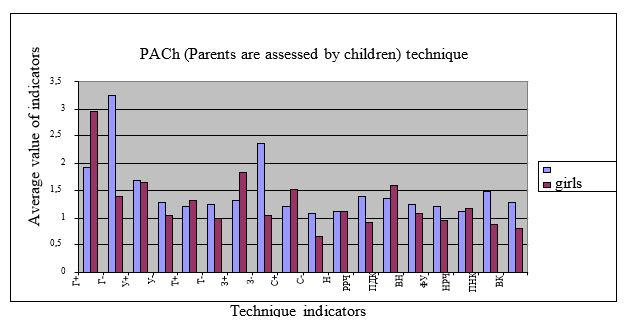
The study of the organizational and communication qualities self-assessment at boys and girls used with L. P. Kalinin technique, Fig.
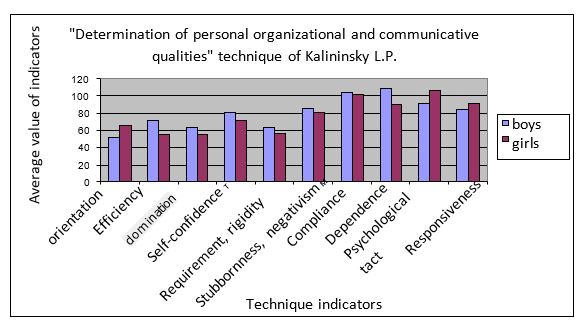
The adaptive behavior is characteristic of teenagers, at boys ‘dependence’ indicator tells us about prevalence of obedience and self-doubt. Compliance and willingness to compromise is characteristic for boys. Girls demonstrate sensitivity and tactfulness, willingness to help.
The study of the communicative competence level and the quality of the basic communicative skills formation of boys and girls was conducted with the help of Michelson's technique. The diagnostic results are shown in Fig.
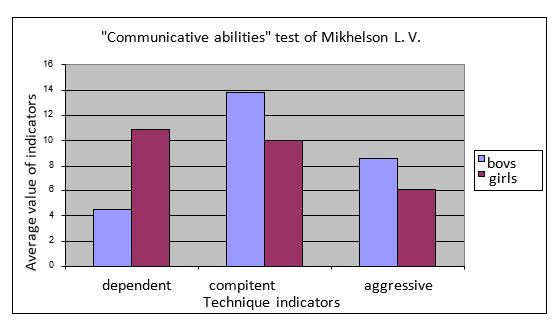
The results revealed that boys have a confident partnership communication style, response to the others behavior depending on the situation. In girls, the "competent" indicator shows average values. The boys are characterized by control of irritation and anger, the girls avoid conflict situations and anger display. For teenage boys, there is a tendency to views independence, assessments and behavior of the individual from the influence of other people in communication situation. And girls show dependence on other people's views, interests and assessments.
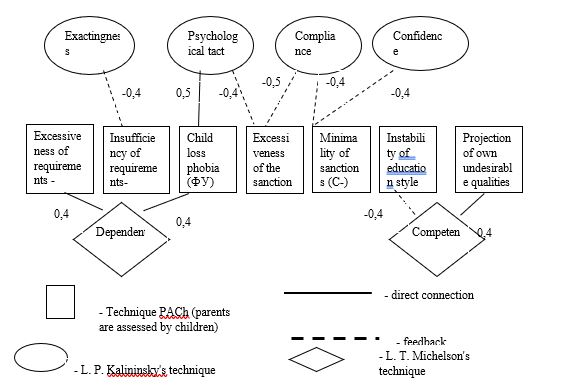
Analysis of the correlation pleiade in Fig.
Analysis of the correlation pleiade Fig.
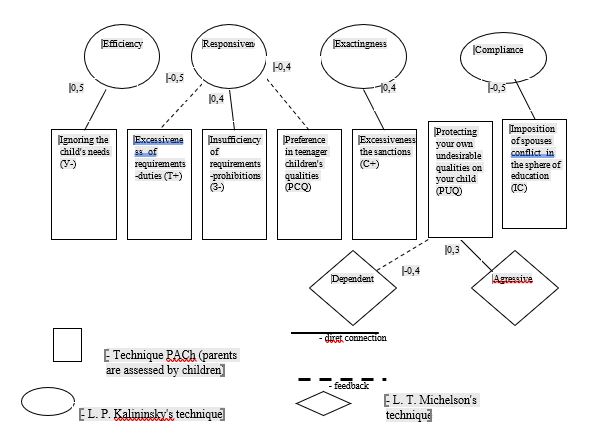
As a part of the study, the following results are achieved: the hypoprotection style predominates in the boys education, a teenager is on the periphery of the parents attention. A predominant style in the girls upbringing is hyperprotection, parents give the child a lot of time and attention, education is the central task of their lives. Boys and girls parents prefer not to punish them at all, or do it very rarely. Studying of a self-assessment of organizing and communicative qualities there was revealed that obedience and self-doubt dominated at teenage boys, girls demonstrate sensitivity and tact. The study of communicative competence level and the basic communicative skills formation quality at boys speaks about the increased level of competent style of communication. Girls have a high dependence on other people's views, interests and assessments.
The analysis of the correlation pleiade shows the presence of parents relationships perception indicators and indicators of communicative culture such as the dependent type of behavior, competent behavior with psychological tact, compliance, confidence is characteristic for the group of teenage boys. The analysis of the correlation pleiade for a group of girls is characterized by the presence of interrelations between the views about the parents' attitude to the indicators of communicative culture as efficiency, responsiveness, exactingness, dependent and aggressive type of behavior, compliance.
Conclusion
During the study, the following results were obtained:
1.It is revealed that hypoprotection prevails in the style of family upbringing of teenage boys - a situation in which he is addressed only when something serious happens. The results of a research show that parents give more their energy, attention, time to educate girls because hyperprotection prevails in the representation of teenage girls in the style of education. Boys and girls parents prefer to do without punishment in education of children.
2.The study of organizational and communicative qualities self-assessment revealed that the adaptive behaviour is characteristic for boys and girls. The study of communicative competence level and formation quality of the basic communicative skills at boys tells us about the increased level of partner style communication. Girls have a high dependence on the opinions of others.
3.The hypothesis was fully confirmed. It is based on the fact that there is a correlation of ideas about the parents attitude and teenage communicative culture and there are differences in the characteristics of the views on the parents relationship and communicative culture at boys and girls, which are caused by inter-sex characteristics.
The materials of the article are of practical value for psychological and pedagogical support in students educational process, as well as in advisory work on the issues of child-parent relations.
Acknowledgments
The work is performed according to the Russian Government Program of Competitive Growth of Kazan Federal University.
References
- Andreeva, G.M. (2001). Social Psychology. Moscow: Aspect Press.
- Applegate, M., & Cohen, J. (2017). Communicating graphically: Mimesis, visual language, and commodification as culture. Public Culture, 13(1), 81-100.
- Biktagirova, G. (2014). Family traditions as they are viewed by contemporary Russian teenagers. In Recent Trends in Social and Behaviour Sciences: Proceedings of the International Congress on Interdisciplinary Behaviour and Social Sciences 2013 (p. 333). CRC Press.
- Biktagirova, G. (2016). The potential of Family Pedagogy discipline in the formation of students family values. Mathematics Education, 11(4), 809-817.
- Biktagirova, G., & Valeeva, R. (2016), Study of family values of adolescents from families with many children formation. Mathematics Education, 11(6), 1919-1926.
- Drozdikova-Zaripova, A.R., & Kostyunina, N.Y. (2016). Helping adolescents with health problems to become socially competent. International Journal of Environmental and Science Education, 11(6), 1079-1090.
- Golod, S. I. (1998). Family and marriage: historical and sociological analysis. St. Petersburg: Petropolis.
- Karpova, S.V. (2009). Parent family as a factor shaping the way of life. In Materials of the International Scientific and Practical Conference (pp. 218-220). Russia, Petrozavodsk: KSPU.
- Kasimova, R., & Biktagirova, G. (2016). Family functions distribution in men and women concepts. International Journal of Environmental and Science Education, 11 (6), 1149-1158.
- Kulik, L. A., & Berestov, N. I. (2009). Family education. Moscow: Prosveshchenie.
- Labella, M. H., & Masten, A. S. (2018). Family influences on the development of aggression and violence. Current Opinion in Psychology, 19, 11-16.
- Minullina, A.F. (2014). Research of anticipation consistency in the families of drug addicts. Middle-East Journal of Scientific Research, 19(8): 1099-1103.
- Murtazina, E.I, Minullina, A.F., & Frolova, A.V. (2014). Pedagogical support aimed to form future pedagogue-psychologists’ readiness to work with the family. Middle-East Journal of Scientific Research, 20(8): 905-909.
- Murtazina, E.I., & Minullina, A.F. (2014). Educational and paternal assumptions of fathers in Islam. Contemporary Issues of Science and Education, 3, 667-705.
- Olifirovich, N.I., Zinkevich-Kuzemkina T.A. & Velenta, Т.F. (2006). Psychology of family crisis. Moscow: Rech.
- Ovcharova, R.V. (2012). Parenthood as a psychological phenomenon. Moscow: Moscow Psychological and Social Institute.
- Poggenpoel, M., Jacobs, F. E., Myburgh, C. P., & Temane, A. M. (2017). Young families become mindful of their possibilities through the appreciation of their family life. Poggenpoel, Health SA Gesondheid, 22, 1-8.
- Raygorodsky, D. (2001). Practical psychodiagnostics. Methods and tests. Training manual. Samara: Bakhrakh-M.
- Ribakova, L., & Biktagirova, G. (2015). Peculiarities of demonstrative behavior manifestations of teenagers brought up in orphanages. Review of European Studies, 7(4), 148-153.
- Rudensky, E.V. (2000). Social psychology: course of lectures. Moscow: INFRA-M.
- Schmidt, N.M., Glymour, M.M., & Osypuk, T.L. (2017). Housing mobility and adolescent mental health: The role of substance use, social networks, and family mental health in the moving to opportunity study. SSM - Population Health, 3, 318-325.
- Semenov, Y. (1974). The origin of marriage and family. Moscow: Mysl.
- Valeeva, R.A, & Biktagirova, G.F. (2016), The problems of family and family education in the works of Tatar educators G. Bubi and R. Fakhretdin. Russian Education and Society, 58(1), 69-75.
- Varga, A. (2010). Systemic family psychotherapy. Moscow: Rech.
- Vorozheykin, E.M. (1975). To young spouses about marriage and family, the rights and duties. Moscow: Jurid. Lit.
Copyright information

This work is licensed under a Creative Commons Attribution-NonCommercial-NoDerivatives 4.0 International License.
About this article
Publication Date
05 September 2018
Article Doi
eBook ISBN
978-1-80296-044-0
Publisher
Future Academy
Volume
45
Print ISBN (optional)
-
Edition Number
1st Edition
Pages
1-993
Subjects
Teacher training, teacher, teaching skills, teaching techniques
Cite this article as:
Murtazina, E. I. (2018). The Relationship Of Family Education Style And Communication Culture In Adolescence Crisis. In R. Valeeva (Ed.), Teacher Education - IFTE 2018, vol 45. European Proceedings of Social and Behavioural Sciences (pp. 438-446). Future Academy. https://doi.org/10.15405/epsbs.2018.09.50

